Craft Traditions – Cooperage (Wooden Barrel Making)
Up until the early 1900s, almost everything was stored or shipped in wooden barrels. Barrels are tough, easy to maneuver, can hold liquids as well as dry powders, don't break like ceramic containers, and can be stacked to utilize storage space effectively.
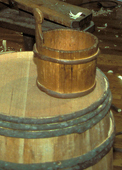
Wooden bucket
sitting atop a
wooden barrel.
Wooden buckets and tubs, which are made the same way as barrels but without fitted lids, were at one time used for all kinds of day-to-day tasks, from carrying milk to washing cloths.
Craftsmen who make wooden barrels are called coopers. The word is most likely derived from the Latin word for vat, "cupa." In New England, coopers arrived with the first English settlers in the 1620s. Their work was essential to commerce and daily life. The fishing industry used barrels for shipping pickled and dried fish. Farmers used them for storing grains, butter and putting up cider. Merchants used them for storing hardware and dried goods of every kind. The whaling industry used barrels to store tools and provisions, and of course whale oil.
New England had a plentiful supply of wood for coopers. White oak was used for casks that held liquids. Red oak, ash, chestnut, pine, and spruce were used for dried goods and everything in between – salted meat, butter, oils, paint, white lead, and even dangerous chemicals like arsenic.
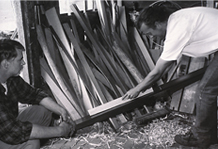
Coooper Ron Raiselis watches
apprentice Michael Dwyer
plane a barrel stave.
Cooperage is a highly skilled trade and in the 19th century it was usually learned through an apprenticeship system. This one-to-one instruction was necessary to ensure that apprentices mastered all the skills necessary to produce barrels that would hold valuable contents. Written apprenticeship contracts usually referred to learning the "secrets and mysteries" of the trade.
Coopers divided their work into three basic categories: "Dry" cooperage - barrels to hold dry goods like nails, tobacco, fruits, and vegetables. "Drytight" cooperage - barrels that kept moisture out of goods like like flour or gun powder; and "Wet" or "Tight" cooperage - barrels for long term storage and transportation of liquids.
In making a barrel, a cooper first shapes the staves, which are the individual pieces that run from the top to the bottom of the barrel. The staves are split (riven) or sawn using draw knives and a jointer plane. The cooper relies on an experienced eye to taper the staves at the ends, which are left wide in the middle to create the center bulge of the barrel.
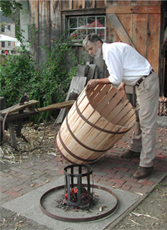
Cooper Ron Raiselis
tips a barrel
over a cresset.
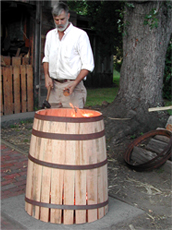
Ron Raiselis taps
metal hoops around
a barrel to bend
in the staves as they
soften from the
fire in the cresset.
The staves are then arranged vertically inside of a metal "raising hoop." The next step is a "firing" process, where scrap wood shavings are put in an iron basket called a "cresset," placed in the center of the barrel, and lit. The fire warms the wood allowing the fibers to relax so the cooper can gradually hammer progressively tighter metal hoops around the barrel until it forms the finished shape-a process called "trussing."
The ends of the cask are then leveled off and a groove cut into the inside edge to receive the barrel heads-the round ends that close up the casks. Almost all 18th and 19th century barrels were finished off by binding them together with wooden hoops, usually made from split hickory, oak, or ash saplings.
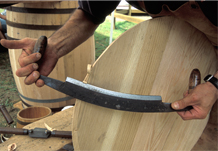
Ron shaving the top of a barrel
with a draw shave knife.
Photographs in this essay are of master cooper Ron Raiselis who demonstrates regularly at Strawbery Banke.
Photo credit: Lynn Martin Graton
New Hampshire State Council on the Arts
19 Pillsbury Street - 1st Floor, Concord, NH 03301


